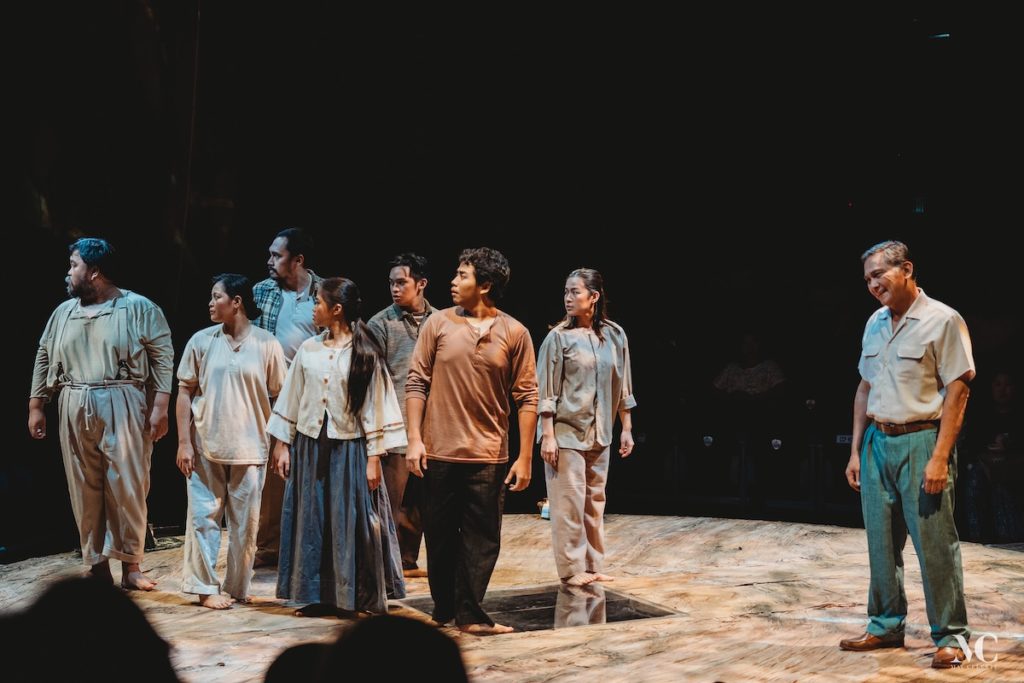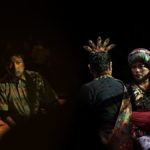We often fall victim to romanticizing the past as we conjure up long-forgotten memories. We fail to perceive how the events of our childhood shapes who we become as adults, our minds subconsciously editing out the unpleasant parts in order to present a rose-tinted vision that may not closely resemble reality. In Balete, an adaptation of F. Sionil Jose’s “Tree”, part of The Rosales Saga is a curiously constructed dive into the banal vagaries of a lingering family curse, complete with atmospheric sound, a sufficiently dark set, and even a Greek chorus composed of Shakespearean ghosts (although, unlike Banquo, these ghosts speak Tagalog, and a bit of Ilocano)
The play opens with the arrival of Kiko (Nonie Buencamino) to his hometown of Rosales, Pangasinan. He is greeted, not by old friends, but by old ghosts. As he waxes nostalgic about what little he recognises from his past in the modern, bustling city that stands before him, we are invited to push aside the vines that hang around the trunk of the giant Balete tree that still stands, slowly being introduced to a series of vignettes in his life that shaped his view of the world. As he walks through the fields around his childhood home, the first of the many ghosts that haunt him materialises in the form of his grandfather (Marco Viana), and we are introduced to one of the main conceits of the play, that the lead character morphs from his current adult self, regressing back to his youth, and at times transforming into a terrifying version of his father, as we are pulled backwards and forwards through time. Kiko’s grandfather dotes on him, imparts the wisdom of his years, and asks him to lie by him out in the open to sleep. This tender exchange between grandfather and grandchild echoes the act of passing down knowledge, and tragically, also subtly reinforces the social injustice of hereditary privilege. The visual here is striking, being his first brush with death, it is done with such poetry. We see his grandfather rise, only to transform into a Bulul before our very eyes, imbuing the space with an atmosphere of mysticism that sets the tone for the entire evening.

As the scene shifts to the family mourning the death of the family patriarch, we are given the opportunity to discover the privileged life Kiko enjoyed. We are introduced to his creative, vaguely queer uncle Tio Marcelo, likewise played by Viana. This choice was clever. In play that deals with family, it could be argued that Marcelo was the one who takes after Kiko’s deceased grandfather. We are also introduced to Kiko’s indulgent nanny and the family’s longtime majordoma, played by Jonathan Tadioan, who serves as Kiko’s main maternal figure due to the death of his mother. It is at the moment where Kiko first becomes Papang, his imperious father.
As the play progresses, it becomes an episodic series of scenes where death and the debts passed on from one generation to the next, we gradually see the vast social and cultural divide developing between the characters. It’s interesting to note that Papang, Kiko’s father, isn’t even the owner of the land he manages, but is rather just a foreman to a largely absent landlord who spends most of his time in Manila. However, Papang still wields immense power within the social framework of the hacienda. His authority being physically represented onstage by a butaka; a piece of obscure furniture today, but has always served as a symbol of mestizo idle privilege. The chair has extended armrests where hacienderos could prop up their legs for a quick siesta after the physically taxing task of surveying their vast farmland. It is worth noting that Papang is the only character who actually sits in it, reinforcing both his authority over his household, but also the vain, bitter desire eating away at him inside: the fact that he’s constantly reminded that despite his relative power, he was still subject to a higher authority.
The flow of the show moves slowly at first as it builds the world, but it eventually accelerates: adding more and more layers of complexity, then unfortunately brings us to a lukewarm finale. The penultimate scene, showing the inevitable revolution that was hinted at throughout the show, was lacking in visual impact, and the payoff was disproportionately benign compared to its build-up. But not all is lost: it would only take a few directorial choices, and a bit of editing to trim down the epilogue, would make this a more visceral, dramatic masterpiece, to match its brilliant writing. I am confident that the incredible talent of Buencamino, and the rest of the company are more than capable of seeing this through.
The set design by Wika Nadera deserves a special mention in that it has so many layers that come together so well. One of the limitations of the CCP – Tanghalang Ignacio Gimenez blackbox is that there’s really no real backstage, so all of the changes and props are done just under the stage. The platform itself is a static round that symbolised the cross-section of a Balete tree. In the middle of the stage, there’s a plexiglass cutout, making the stage a giant Chinese coin, further contextualising the symbolism of greed that fuels so much social injustice around the family.
You always come across plays that serve as social commentary about the dangers of hereditary privilege, and the injustice that results from the perpetuation of these systems, but rarely do you see it being treated with the extraordinary care this production dared to do. This is not entirely unexpected given Tanghalang Pilipino’s illustrious legacy and dedicated commitment to moving Filipino theatre forward. It is raw, and thoughtful, and real. It is not “pretty” nor it is “pleasant”, but then again: reminiscences never truly are.
Click here for more stories like “Balete”. You may also follow and subscribe to our social media accounts: Facebook, YouTube, Instagram, TikTok, Twitter, and Kumu.






















